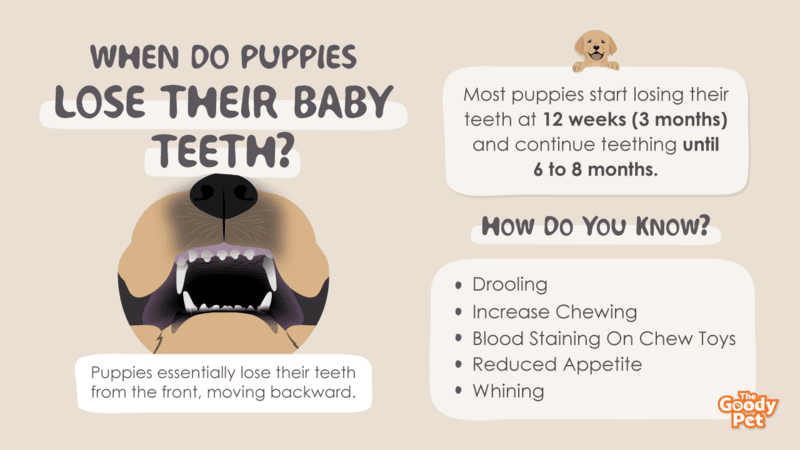If you are considering getting a puppy or already have one, then you have no doubt already come across several warnings about the notorious teething phase. You are probably already prepared for all the tantrums and destructive chewing tendencies. This is just the tip of the iceberg.
The most important tip to preparing for the teething period is understanding the timeline. Teething in puppies typically starts at 12 weeks of age and runs until 6 to 8 months for dog breeds.
Let’s dive a little deeper into this timeline, including what to expect through every phase of the teething process.
At What Age Do Puppies Start To Lose Their Teeth?
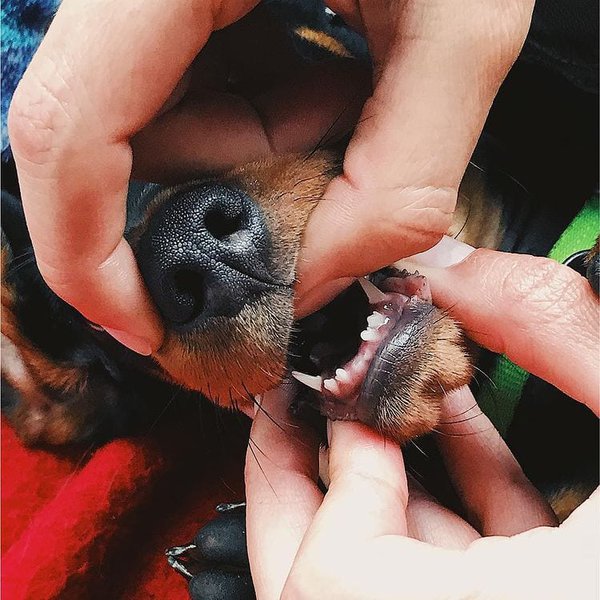
Most puppies start to lose their milk teeth when they reach the age of 12 weeks. This is approximately at 3 months. However, there are some dog breeds that may start as early as 8 weeks which corresponds to 2 months of age.
The process of teething runs for about 4 to 6 months, with permanent teeth being fully erupted by the age of 8 months with most dog breeds.
What most people do not understand about puppy teething is the fact that, like human children, the process of losing deciduous teeth and the eruption of permanent teeth occurs simultaneously.
It may therefore be difficult to keep track of the process by examining the dog’s mouth as there are rarely ever large gaps in their gums. This is why most people often misunderstand the teething timeline.
In What Order Do Puppies Lose Their Teeth?
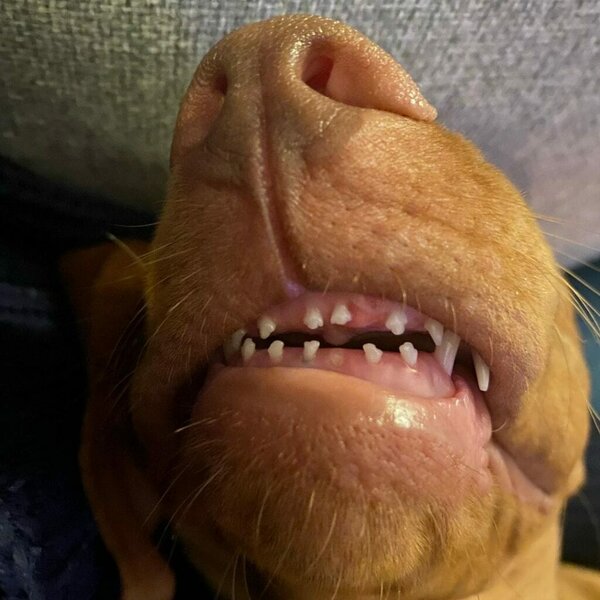
Puppies essentially lose their teeth from the front, moving backward. Let’s take a look at the specific order and essential milestones during the puppy’s teething process.
Incisors
The incisors are typically the first to go with the process starting between the 2nd and 3rd month of life for the puppy. These teeth are also the first to grow back, with the permanent set erupting fully by the 5-month mark.
Canines
As carnivores, canines are arguably the most important teeth in your dog’s mouth. These are what the pooch will use to defend itself, dig into their meals, and slice up meat chunks into more manageable bites.
It thus comes as no surprise that they are typically among the last of the teeth to be shed, with their loss happening at about five months. Incisors also happen to grow back very fast, with permanent ones growing back by six months.
Premolars And Molars
Both premolars and molars share a pretty similar puppy teething schedule. The premolars are lost as early as the 4th month, and their permanent replacements grow back by the 6th month.
With molars, those at the very back take a bit longer to erupt, with the permanent set needed to complete the 42-teeth count erupting fully at the 7th or 8th month mark.
How Do You Know When Your Puppy’s Teeth Are Falling Out?
If you want to figure out when and whether your puppy has started teething, you have to look out for important physical and psychological signs.
To help you out, here are the most important telltale signs that your puppy’s teeth are falling out.
Drooling
When your dog starts to lose teeth and have new ones erupt, its gums will be very irritated. One way their bodies cope with the discomfort is by increasing the amount of saliva produced. Dog saliva has a pain-relieving compound known as opiorphin which offers some relief to the puppy.
When your pup starts teething, you may therefore notice them drooling or licking their lips more than usual. This may be a bit hard to distinguish from regular drooling in dog breeds that already drool a lot.
Increase Chewing And Biting Tendencies
Another adaptive mechanism that teething puppies have to help reduce the pain from teething is biting and chewing on pretty much anything they can find. This is the part of the teething process that you have already been warned about.
Fortunately, there are many different chew toys in different shapes, sizes, materials, and textures that you can stock up on so your pup doesn’t have to destroy your property for relief.
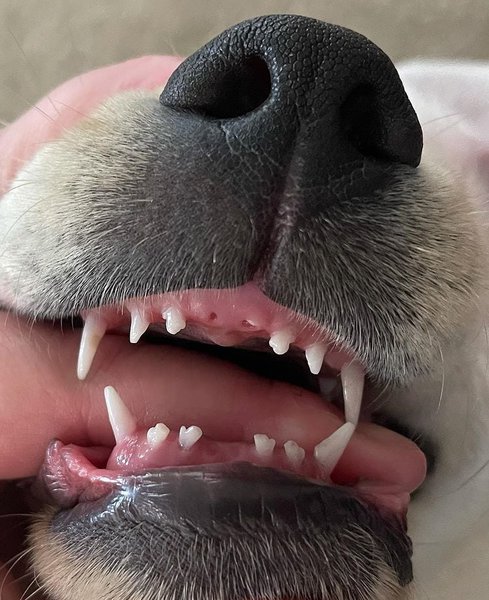
Blood Staining On Chew Toys
While we are still on the topic of chewing, you may notice some blood staining on your dog’s chew toys.
This is completely normal and will usually resolve itself as the dog continues to apply chewing pressure on the spot left by the shed teeth.
Reduced Appetite And Failure To Thrive
Puppy teething can be so uncomfortable at times that the puppy is unwilling to eat. They will particularly avoid foods that are too hard as these only worsen the discomfort. In severe cases, the loss of appetite could result in severe weight loss for the pooch.
Fortunately, there is a simple solution here, and all you have to do is switch to softer dog foods as your puppy goes through its transition.
Bleeding, Swollen Gums
If you examine your puppy’s mouth as they are going through the teething period, you may notice some swelling of the gums. There may even be bleeding in cases where a tooth was recently shed.
Cool water does a lot to relieve the discomfort and reduce the inflammation of your pooch. Therefore, make sure that they always have access to a cool, fresh bowl of water.
Whining
Whining and other signs of pain and discomfort in dogs could also clue you in as far as figuring out when your puppy is teething. This is simply their way of letting you know that they are not comfortable.
If the whining continues and is accompanied by other worrying signs like reduced appetite and reduced activity levels, you may want to consult a vet. This will help you rule out complications like infected gums or persistent deciduous teeth.
How Can You Tell Your Puppy Is Done Teething?
There are many ways to tell when your puppy is done teething, but the most accurate is counting its teeth. However, there are other equally valuable methods that you could use. Let’s dive right into all these clues.
Count The Number Of Teeth
Puppies have 28 deciduous teeth and 42 permanent/adult teeth.
If you can safely count the number of teeth in your puppy’s mouth and have the latter as your total, then you can rest assured that the teething process is complete.
However, if there is impaction due to persistent deciduous teeth, you may not be entirely out of the woods, and your puppy will still be very uncomfortable.
Timing
You could also tell whether or not your puppy is teething by keeping track of the calendar. On average, teething lasts 4 to 6 months and is usually all done by the age of 8 months.
Therefore, if your puppy is already at this age, you can more or less safely conclude that they are done with the teething.
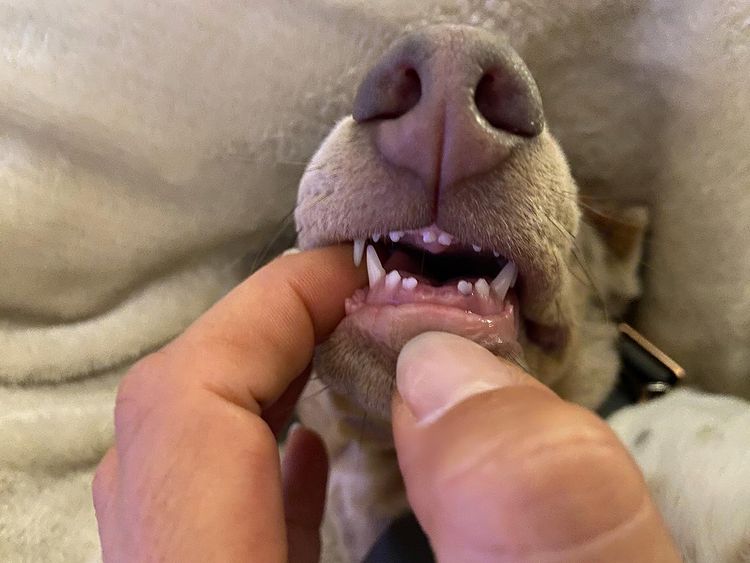
Change In Behavior
Teething can be a very stressful tie for the dog and often changes their behavior in a drastic manner.
If you notice your dog has calmed down and become less destructive after a few stressful months, the chances are that they are no longer experiencing the discomfort responsible for their previous moods.
Change In Size And Strength Of The Teeth
Assessing the size and general strength of the puppy’s teeth could also serve as an indicator of whether or not your puppy is done teething. Permanent teeth are typically larger, stronger, and sharper.
However, this is far from being accurate or reliable as a method.
Do Puppies Stop Biting After They Lose Their Teeth?
Puppies will only stop biting after they lose their teeth if you train them to stop. This is because the discomfort of teething is not the only reason why they chew and bite on things.
If you don’t want to deal with destroyed property, it is best to invest in chew toys and train your dog to let out their frustrations on those by using reward systems.

